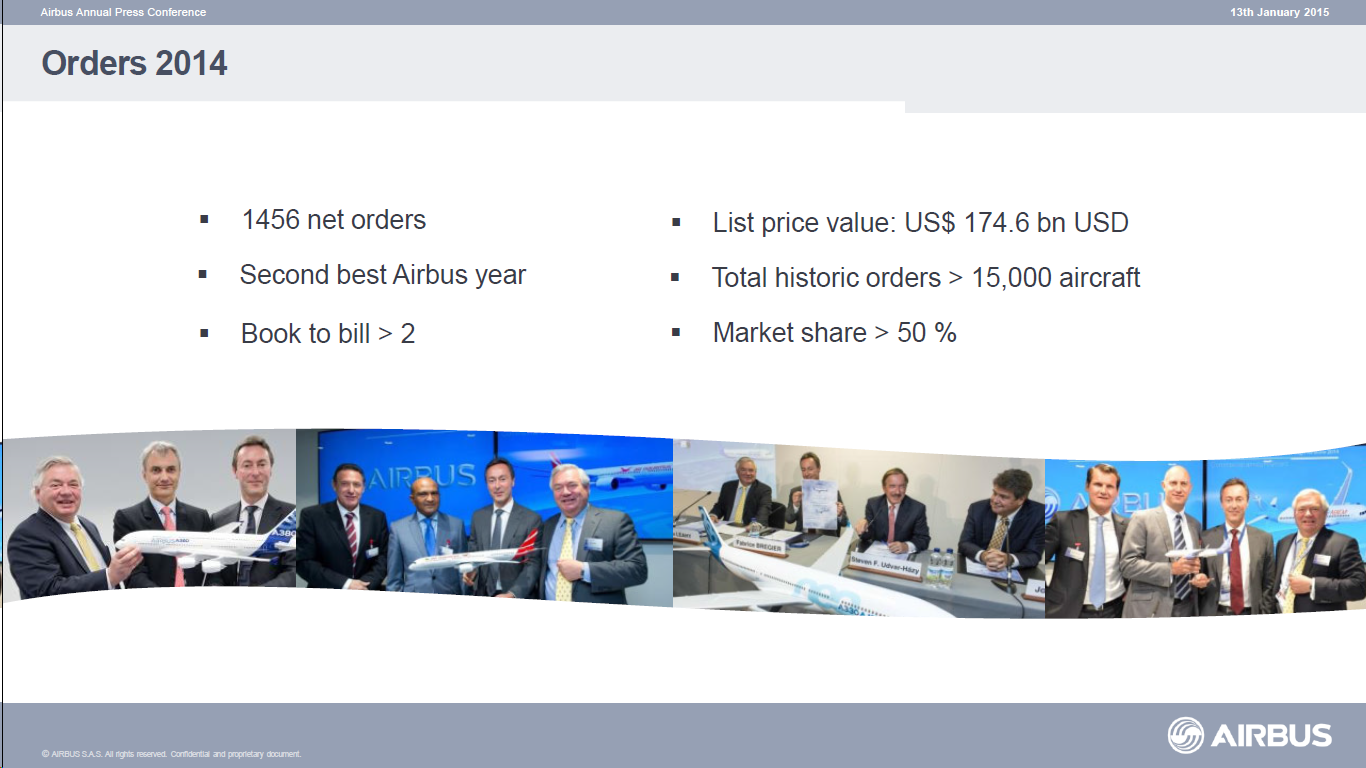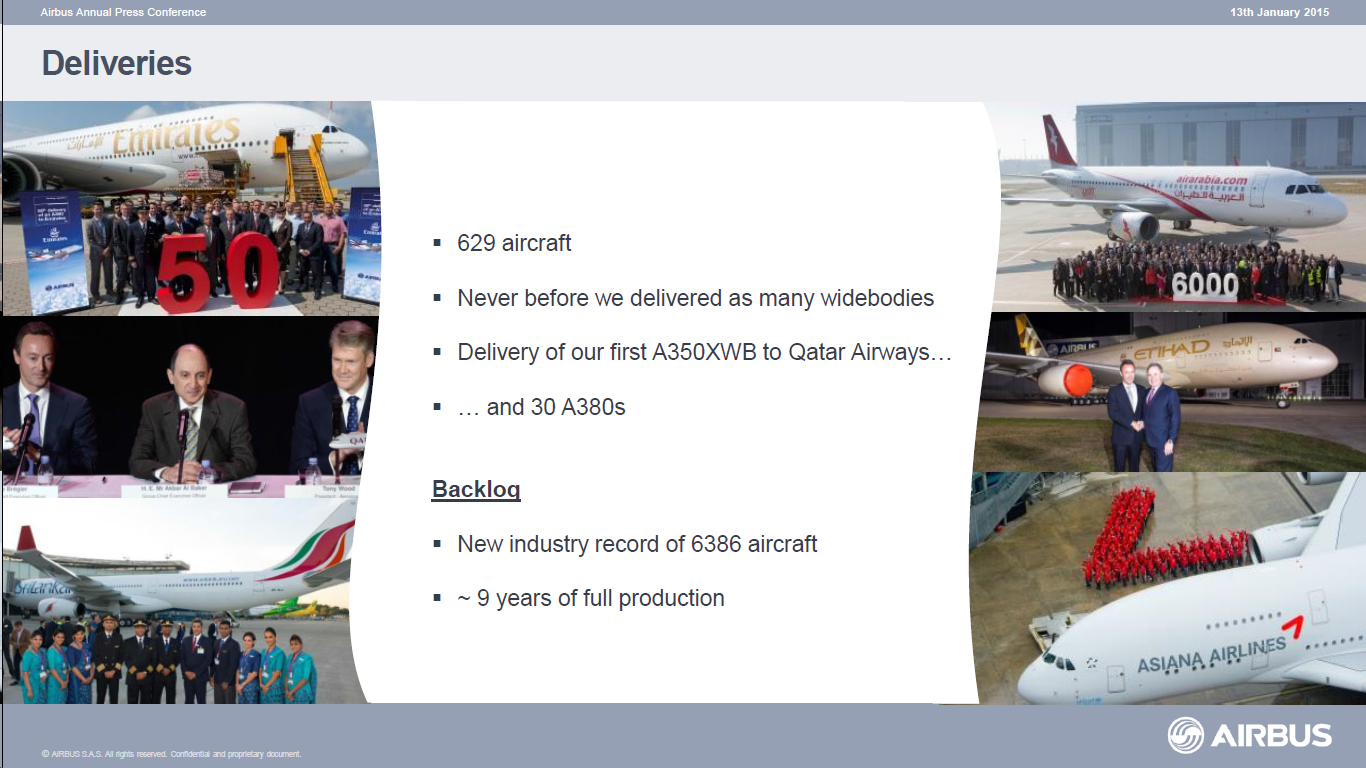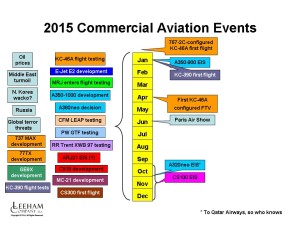Leeham News and Analysis
There's more to real news than a news release.
 Leeham News and Analysis
Leeham News and Analysis
- SPEEA, Boeing at impasse over safety program, union says April 23, 2024
- Better transparency needed on Boeing’s 1Q earnings call April 22, 2024
- Bjorn’s Corner: New engine development. Part 4. Propulsive efficiency April 19, 2024
- Boeing unlikely to meet FAA’s 90-day deadline for new safety program April 18, 2024
- Focus on quality not slowing innovation, says GKN April 18, 2024
Odds and Ends: BBD management; AirAsia 8501; MH370 update; Holy cow
BBD management: Bombardier’s management gets a scathing review following last week’s announcement that it will “pause” the LearJet 85 program and it will miss free cash flow guidance. This follows the unexpected resignation of Ray Jones, the head of sales, and a 10-year veteran of the company. Aviation Week has a separate article refuting the “poor business climate” excuse BBD gave for business jets.
Our own conversations paint a picture of a management structure that has inhibited CSeries sales from the start.
AirAsia 8501: Preliminary analysis of the AirAsia flight 8501 Cockpit Voice Recorder indicates no sign of terrorism or pilot suicide, according to several press reports. More likely is a high altitude stall or aircraft upset, the reports say.
In our conversations with a former NTSB crash investigator, he believes the flight spiraled down, hit the water and broke up upon impact.
MH370 Update: Flight Global has a good piece updating the search for Malaysia Airlines flight MH370.
Holy cow: Readers know we follow the Seattle Seahawks closely. Sunday’s game against the Green Bay Packers was a heart-stopper. Seattle trailed for 57 minutes of the 60 minute game and then exploded to come from a 19-7 deficit to win 28-22 in Overtime. What a thriller. Now the Seahawks will meet the New England Patriots in Arizona February 1 for the Super Bowl. The Pats crushed the Indianapolis Colts Sunday.
We’re negotiating our bet with an exec at Pratt & Whitney this week….
Unfortunately, Boeing won’t be repeating its 747-8F-painted Seahawks airplane this year, according to the USA Today. What a shame.
Posted on January 19, 2015 by Scott Hamilton
Airbus reveals record orders at annual press conference
By Bjorn Fehrm
Toulouse 13 Jan 2015: Airbus today held their annual press conference where they among other things revealed their final numbers for orders and deliveries. The press conference was hosted by Airbus CEO Fabrice Bregier accompanied by COO Customers John Leahy, new COO Tom Williams and new Head of Programs Didier Evrard.
Airbus in 2014
Bregier started with pointing out that 2014 was a very eventful year for Airbus. Airbus did their customary end of year sprint and passed Boeing for net orders with 24 aircraft netting 1456 commands, Figure 1.
On the delivery side Boeing is ahead with 723 deliveries versus Airbus 629, Figure 2.
Further Airbus certified the A350 and delivered the first aircraft to its launch customer, Qatar Airways. It also launched the A330neo and got 120 orders during the year. Finally they flew the A320neo first prototype.
Posted on January 13, 2015 by Bjorn Fehrm
A380neo decision likely this year, triggering the next widebody engine project
Subscription required
By Bjorn Fehrm
Introduction
Jan. 12, 2015: One of the subjects which is sure to come up on Airbus annual press conference on Tuesday the 13th in Toulouse will be when and how Airbus will re-engine the A380.
Airbus Commercial CEO Fabrice Bregier vowed during the Airbus Group Global Investors Day last month that an A380neo is coming.
There is much speculation around this subject as the business case of re-engineering an aircraft that is selling at such low numbers is difficult to get to close. The business case is difficult to make work for Airbus  (such a project will cost in the order of $2 billion) but it will be equally hard for the engine manufacturers to offer engines that have enough efficiency gain to make the overall project feasible from an efficiency improvement perspective.
(such a project will cost in the order of $2 billion) but it will be equally hard for the engine manufacturers to offer engines that have enough efficiency gain to make the overall project feasible from an efficiency improvement perspective.
Summary
- A380 Classic equals Boeing 777-300ER seat fuel costs.
- Boeing 777-9 beats A380 on CASM, an A380neo regains the advantage.
- Engine makers face hard choices to retain dominance or to broaden market penetration.
Posted on January 12, 2015 by Bjorn Fehrm
Aging Boeing 757 engines skew operating expenses
Jan. 8, 2015: Engines on the aging fleet of Boeing 757s are a key reason operating costs of this rather unique airplane are between 20% and 30% more than a Boeing 737-9 or an Airbus A321neo.
“The thing to worry about most for the 757 engines is the cost to overhaul,” says an industry official who trades in 757s. “The cost of producing life limited parts is crippling the marketplace.”
Total costs and the direct operating costs are being directly affect by the engine costs, the person says, who doesn’t want to be identified because of the sensitivity of the topic.
Posted on January 8, 2015 by Scott Hamilton
Airbus/Boeing duopoly single-aisle is safe well into 2030 decade
Subscription Required
Introduction
Dec. 28, 2014: Two challenges to the duopoly of Airbus and Boeing in the 150-220 seat single-aisle sector move forward in development in 2015, but neither is in a position to be a threat for the balance of this decade, nor even in the next.
Both challenges, the COMAC C919 from China, and the Irkut MC-21 from Russia, will for various reasons fall short of the Airbus A320/321 and Boeing 737-8/9 and plans to design the next generation new single-aisle airplane.
Summary
- The C919’s chief advantage was eliminated when Airbus and Boeing moved to reengine the A320 and 737 families.
- C919 retains pricing advantage but won’t overcome duopoly dominance.
- By the time the C919 enters service, Airbus and Boeing will have the second generation of LEAP and GTF engines available.
- The MC-21 takes into account better passenger comfort through a wider fuselage, but engines will be no better than those used on Airbus and Boeing.
- The MC-21 sales potential will be highly limited because Russia still hasn’t become a full trading partner due to political direction.
Looking ahead in 2015 in commercial aviation
Here’s a visualization of events to look for in commercial aviation in 2015.
Posted on December 26, 2014 by Scott Hamilton
Airbus, Boeing, Bombardier, CFM, China, Comac, CSeries, Embraer, GE Aviation, Mitsubishi, Paris Air Show, Pratt & Whitney, Rolls-Royce
767-2C, A320NEO, A350-1000, A350-900, A380neo, air force tanker, Airbus, Boeing, Bombardier, CFM, CSeries, E-Jet E2, Embraer, GTF, KC-46A, LEAP, MC-21, Mitsubishi, MRJ, Pratt & Whitney, Qatar Airways, Rolls-Royce, Trent XWB
New UTC CEO throws cold water on PW GTF growth
The new chief executive officer of United Technologies Corp., Gregory Hayes, threw cold water on hopes and dreams of Pratt & Whitney, a subsidiary, that the successful small- and medium-sized Geared Turbo Fan will grow into the wide-body market.
Aviation Week just published an article in which all three engine OEMs were reported to be looking at a 40,000 lb engine that would be needed to power a replacement in the category of the Boeing 757 and small 767. Hayes did not specifically rule out a 40,000 lb engine, leaving PW’s potential to compete for this business unclear.
Hayes has been CEO for two weeks. He was previously CFO. He made his remarks in a UTC investors event last night. The Hartford Courant has this report.
Hayes’ remarks were in response to a question from an analyst about research and development expenses. Here is his reply, from a transcript of the event:
Posted on December 12, 2014 by Scott Hamilton
Boeing, Bombardier, CFM, Comac, CSeries, Embraer, Irkut, Mitsubishi, Pratt & Whitney, Rolls-Royce
737 MAX, 757, 757 replacement, 767, 767 replacement, A320NEO, Alain M. Bellemare, Bombardier, C919, CFM, Comac, CSeries, E-Jet E2, Embraer, GE Aviation, Gregory Hayes, GTF, Irkut, MC-21, Mitsubishi, MRJ, Pratt & Whitney, United Technologies
MTU investors day: views of its engine programs, future airplane timelines; separately, Embraer COO interview

Figure 1. Technical milestones have been passed on PW GTF programs for the applications on Bombardier, Airbus, Mitsubishi and Irkut airplanes and are approaching for Embraer. Source: MTU Investors Day. Click to enlarge.
Nov. 30, 2014: MTU Investors Day: MTU is a major participant in engine development and supplies, participating on the GEnx, GTF and GEnx program. It’s also a member of the joint venture in International Aero Engines and it’s a major player in the aftermarket Maintenance, Repair and Overhaul (MRO) sector, providing a serious competitive alternative to the aftermarket contracts offered by the engine OEMs. Its held an investors day conference Nov. 25. Highlights included:
- Milestones have been passed on the Pratt & Whitney Geared Turbo Fanengine for the Bombardier CSeries, Airbus A320neo family, the Mitsubishi MRJ and Irkut MC-21; and are on schedule for the Embraer E-Jet E2.
- The success of the GTF is requiring huge production commitments.
- The large number of airplane/engine programs require a major ramp-up of production during the next few years.
- The major investment in new engines is largely over for now, leading to the expectation of long-term revenue from MRO.
Posted on November 30, 2014 by Scott Hamilton
Boeing considers single, twin aisle, co-development 757/767 style for next new airplane
Subscription required.
Now open to all Readers.
Introduction
Boeing is looking at a number of scenarios for its New Airplane Study (NAS) that would replace the 757 and 737, have ranges from 4,000nm-5,000nm, and carry as few passengers as 130 or as many as 240.
 To cover this broad range of demands could require reverting back to the 1980s when Boeing simultaneously developed two airplanes serving very different missions, the 757 and 767, that shared cockpits and some other common elements.
To cover this broad range of demands could require reverting back to the 1980s when Boeing simultaneously developed two airplanes serving very different missions, the 757 and 767, that shared cockpits and some other common elements.
Boeing faces some hard decisions in the coming years, as Airbus outflanks Boeing in the single-aisle sector with the A320neo family and its latest offering, the A321neoLR. Our analysis and sales figures show the 737 MAX falling further and further behind in market share as MAX 9 lags vis-à-vis the A321neo.
We spoke with Kourosh Hadi, director of product development at Boeing, during a break at a conference last week organized by the British American Business Council-Pacific Northwest, and covered this and a number of other topics.
Summary
- Boeing is studying a New Light Twin (NLT) and New Single Aisle (NSA) to replace the 757 and 737 airplanes.
- The tipping point between an efficient NSA and the NLT is around the passenger size of the 757-200.
- Boeing is evaluating materials, including metals and composites, for the NAS and the manufacturing process, which will also be a determining factor in the materials for the new airplane.
- Engine advances for the 777X’s GE9X are beyond the GEnx and CFM LEAP of today and could help drive the next new small engine technology.
- Although having a miniscule portion of the 100-150 seat market, Boeing today plans to continue participation in at least the 130 or 150 seat sector even as airplane size moves up every year.
Posted on November 2, 2014 by Scott Hamilton
Airbus, Boeing, CFM, GE Aviation, Pratt & Whitney, Rolls-Royce
737 MAX, 737-9, 757, 757-200, 757-300, 767, 787, A320NEO, A321NEO, A321neoLR, Airbus, BABC-PNW, BACB, Boeing, British American Business Council, CFM, GE Aviation, GE9X, GTF, Kourosh Hadi, LEAP, NAS, New Airplane Study, New Light Twin, New Single Aisle, NLT, NSA, Pratt & Whitney, Rolls-Royce, Ultra Fan
Email Subscription
Twitter Updates
My TweetsAssociations
Aviation News-Commercial
Commentaries
Companies-Defense
Resources
YouTube
Archives
- April 2024
- March 2024
- February 2024
- January 2024
- December 2023
- November 2023
- October 2023
- September 2023
- August 2023
- July 2023
- June 2023
- May 2023
- April 2023
- March 2023
- February 2023
- January 2023
- December 2022
- November 2022
- October 2022
- September 2022
- August 2022
- July 2022
- June 2022
- May 2022
- April 2022
- March 2022
- February 2022
- January 2022
- December 2021
- November 2021
- October 2021
- September 2021
- August 2021
- July 2021
- June 2021
- May 2021
- April 2021
- March 2021
- February 2021
- January 2021
- December 2020
- November 2020
- October 2020
- September 2020
- August 2020
- July 2020
- June 2020
- May 2020
- April 2020
- March 2020
- February 2020
- January 2020
- December 2019
- November 2019
- October 2019
- September 2019
- August 2019
- July 2019
- June 2019
- May 2019
- April 2019
- March 2019
- February 2019
- January 2019
- December 2018
- November 2018
- October 2018
- September 2018
- August 2018
- July 2018
- June 2018
- May 2018
- April 2018
- March 2018
- February 2018
- January 2018
- December 2017
- November 2017
- October 2017
- September 2017
- August 2017
- July 2017
- June 2017
- May 2017
- April 2017
- March 2017
- February 2017
- January 2017
- December 2016
- November 2016
- October 2016
- September 2016
- August 2016
- July 2016
- June 2016
- May 2016
- April 2016
- March 2016
- February 2016
- January 2016
- December 2015
- November 2015
- October 2015
- September 2015
- August 2015
- July 2015
- June 2015
- May 2015
- April 2015
- March 2015
- February 2015
- January 2015
- December 2014
- November 2014
- October 2014
- September 2014
- August 2014
- July 2014
- June 2014
- May 2014
- April 2014
- March 2014
- February 2014
- January 2014
- December 2013
- November 2013
- October 2013
- September 2013
- August 2013
- July 2013
- June 2013
- May 2013
- April 2013
- March 2013
- February 2013
- January 2013
- December 2012
- November 2012
- October 2012
- September 2012
- August 2012
- July 2012
- June 2012
- May 2012
- April 2012
- March 2012
- February 2012
- January 2012
- December 2011
- November 2011
- October 2011
- September 2011
- August 2011
- July 2011
- June 2011
- May 2011
- April 2011
- March 2011
- February 2011
- January 2011
- December 2010
- November 2010
- October 2010
- September 2010
- August 2010
- July 2010
- June 2010
- May 2010
- April 2010
- March 2010
- February 2010
- January 2010
- December 2009
- November 2009
- October 2009
- September 2009
- August 2009
- July 2009
- June 2009
- May 2009
- April 2009
- March 2009
- February 2009
- January 2009
- December 2008
- November 2008
- October 2008
- September 2008
- August 2008
- July 2008
- June 2008
- May 2008
- April 2008
- March 2008
- February 2008





Boeing 737 MAX 8 as a long and thin aircraft and how it fares in general versus Airbus A320neo.
Subscription required.
By Bjorn Fehrm
Introduction
Over the last weeks we have looked at Boeing’s 757 replacement possibilities on its long and thin network niche, including a ground breaking launch interview for the A321neoLR with Airbus Head of Strategy and Marketing, Kiran Rao. In the series we have seen that the A321neo has the potential to replace the 757-200 on long and thin international routes. Boeing’s equivalent single aisle entry, 737 MAX 9, has problems to extend its range over 3,600nm. It is too limited in the weight increase necessary to cover the longer range.
Marketing, Kiran Rao. In the series we have seen that the A321neo has the potential to replace the 757-200 on long and thin international routes. Boeing’s equivalent single aisle entry, 737 MAX 9, has problems to extend its range over 3,600nm. It is too limited in the weight increase necessary to cover the longer range.
Many have asked how the less- restricted Boeing 737 MAX 8 would fare, suitably equipped with the necessary extra tanks. This is the subject of this week’s sequel on the theme long and thin. At the same time we look at Airbus entry in this segment, the A320neo, to see how it stacks up to the 737 MAX 8, both in their normal 1,000 to 2,000nm operation and then also in a long and thin scenario.
Let’s first summarize what we found so far in our four articles around the Boeing 757 and its alternatives:
Summary
Figure 1. Boeing 737 MAX 8 overlaid with Airbus A320neo. Source: Leeham Co.
Read more
4 Comments
Posted on November 9, 2014 by Bjorn Fehrm
Airbus, Airlines, Boeing, CFM, GE Aviation, Leeham Co., Leeham News and Comment, Pratt & Whitney, Premium, Rolls-Royce
737, 737 MAX, 737NG, A320, A320NEO, Airbus, Boeing, CFM, Pratt & Whitney, Rolls-Royce